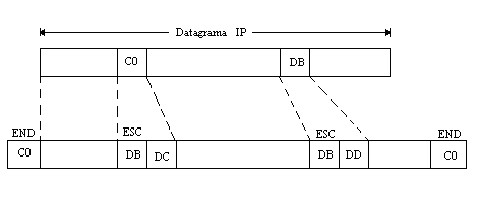Serial Line Internet Protocol
The SLIP protocol (Serial Line Internet Protocol) is an IP datagram transmission standard for serial lines, but it has become quite obsolete. It was designed to work through serial port and modem connection. Its specification is found in document RFC 1055.
On PC, SLIP has been replaced by PPP (Point-to-Point Protocol) whose design is superior, has more and best features and does not require the configuration of your IP address before being established. However, with microcontrollers, the encapsulation mode of SLIP is still used for IP packets since it uses small size headers.
Description
This protocol works on a wide variety of networks such as Ethernet (802.3), token ring (802.5), local area networks (LAN), X-25 lines, for point-to-point connections under TCP/IP connections, or remote access that UNIX servers used to use.
SLIP requires a port configuration of 8 data bits, no parity, and accepts any of the EIA (Electronic Industries Alliance) hardware flow controls. A version of SLIP with header compression is CSLIP (Compressed SLIP). It was developed by Van Jacobson and its functionality consists of reducing the typical 40-byte header to 3 or 5 bytes, using the fact that many of the fields of Bluetooth communication between computers help.
History
SLIP has its origins in the 3 COM UNET TCP/IP implementation and was designed in 1984 by Rick Adams. SLIP is simply a string definition for carrying IP packets on a serial line. Being a protocol that is very easy to implement, it does not provide addressing, packet type identification, error detection/correction, or compression mechanisms. Already in 1984 it was possible to easily connect hosts and routers via serial lines. SLIP can be used on lines with speeds between 1200 bps and 19.2 Kbps. The most common SLIP configurations will be: host-host, host-router and router-router.
Format
SLIP modifies each IP datagram by adding a special character C0 or “SLIP END” that allows distinguishing between different datagrams. To prevent line noise it is customary to send one at the beginning as well; so that any previous wrong connection type is terminated.
If the character C0 occurs in the datagram content, the two-byte sequence DB,DC is used. The DB character is the escape character of SLIP (other than the ASCII value of ESC –1B--).
If the escape character is present in the content; is replaced by the sequence DB, DD.
Types
Dynamic SLIP: When SLIP is used to connect to the Internet, the Internet access provider's server identifies the computer by giving it an IP address (for example 150.214.110.8). Through dynamic SLIP, this address is dynamically assigned by the server from a pool of addresses. This address is temporary, and lasts for the duration of the connection.
Static SLIP: When using static SLIP, the ISP's server assigns a permanent address to the computer for use in all sessions.
Shortcomings
SLIP is a very simple protocol that was designed and has the following drawbacks:
- Direction: The two hosts need to know in advance the IP address of the other end. In addition, SLIP does not provide mechanisms to hosts to communicate these IP addresses.
- Type identification: The SLIP protocol does not have type identifier, so only one protocol can be used simultaneously resulting in this way an inconvenience to the current multiprotocol machines.
- Detection and correction of errors: Due to the existing noise in telephone lines, errors occur when transmitting packages and because of the low speed of these lines the cost of resentment is very high. It should be noted that the detection of errors is not strictly necessary because the IP protocol detects the wrong packages. However, it would be advisable for SLIP to have a bug detection and correction system on its own.
- Compression: It would be advisable to have some compression mechanism to reduce the time needed for transmission of a package caused by the low speed of the line. The compression can be used in the TCP and IP headers as they have a high redundancy by sending only the changes that occur between successive transmissions.
A successor to SLIP is in the works to fill these gaps. The high-level language implementation of SLIP is straightforward. For more information on SLIP, see RFC 1055.
SLIP vs. PPP
The SLIP protocol serves the same function as PPP, but it is a much older protocol.
| SLIP | PPP |
|---|---|
| Easy to implement. | More complex. |
| Add very few overhead bytes. | Major overhead. |
| Used by many applications. | Your use is growing. |
| It makes overhead compression (CSLIP). | It can be configured to use overhead compression. |
| Not standard. | Standard. |
| It does not detect or correct errors. | Amount of verification (CRC) in each framework. |
| It only recognizes IP. | Multiple protocols. |
| The IP of each end must be known. | Allows dynamic IP mapping. |
| Unreliable. | Optional reliable transmission. |
| Static. | Configurable via LCP. |
Links of interest
- RFC 1055
- Official EIA site
Contenido relacionado
Sinclair ZX Spectrum
GNU Project
Object-oriented programming
